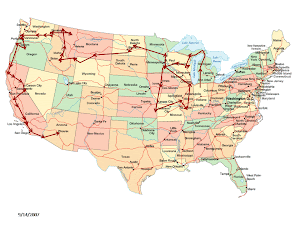 It's rainy, but still beautiful
It's rainy, but still beautiful
 Kim loves falls
Kim loves falls
Viewing fish going through the ladder
Yesterday we went to the Bonneville Lock and Dam. The most interesting thing for me was the fish ladder. I always thought the ladder was something that looked like a stairway with hollow steps and water flowed down it and the fish leaped from one step up to the next. That is only a part of it. There are also a series of cells with vertical slots that the water can flow through. The fish swims through a slot of incoming water and then gets to rest in the larger cell. Then the next slot and so on till they are in the upstream waters. This whole thing is necessary because the dam has blocked the natural swim upstream for the fish.
We also learned a lot about salmon. There is one species of salmon on the east coast but ten on the west coast. Salmon spawn upstream and have up to 8,000 eggs. The eggs hatch into baby salmon which are called alevin. When the alevin are ready to swim they are called fry. Fry look like tiny fish. When fry are silver and ready to swim to the ocean, they are called smolts. In the ocean, smolts feed and grow into adults. When adult salmon are ready to spawn (1 to 8 years depending on the species) they swim back to their home streams. They find their home stream by their keen sense of smell. A migrating salmon does not eat. It lives off the fat and protein stored in its body. At the streams, spawners lay and fertilize eggs. After spawning, most Pacific salmon die. Steelhead and Atlantic salmon swim back to the ocean. Most salmon die after one spawning, but the strong Atlantic salmon spawn up to seven times. There are one sixth of the salmon that there were 100 years ago. Salmon are one of the few fish that live in both fresh water and salt water.
We also saw many, many waterfalls. We hiked to a few and had a great time. This is the first non-ideal weather we’ve had on the trip. The last four days have been 55 – 60 and sprinkles or rain most the time. It does rain 80 inches a year here compared to 40 in Indiana. This is their typical winter weather.
We also learned a lot about salmon. There is one species of salmon on the east coast but ten on the west coast. Salmon spawn upstream and have up to 8,000 eggs. The eggs hatch into baby salmon which are called alevin. When the alevin are ready to swim they are called fry. Fry look like tiny fish. When fry are silver and ready to swim to the ocean, they are called smolts. In the ocean, smolts feed and grow into adults. When adult salmon are ready to spawn (1 to 8 years depending on the species) they swim back to their home streams. They find their home stream by their keen sense of smell. A migrating salmon does not eat. It lives off the fat and protein stored in its body. At the streams, spawners lay and fertilize eggs. After spawning, most Pacific salmon die. Steelhead and Atlantic salmon swim back to the ocean. Most salmon die after one spawning, but the strong Atlantic salmon spawn up to seven times. There are one sixth of the salmon that there were 100 years ago. Salmon are one of the few fish that live in both fresh water and salt water.
We also saw many, many waterfalls. We hiked to a few and had a great time. This is the first non-ideal weather we’ve had on the trip. The last four days have been 55 – 60 and sprinkles or rain most the time. It does rain 80 inches a year here compared to 40 in Indiana. This is their typical winter weather.
Today we went to the “End of the Oregon Trail Interpretive Center”. We would strongly recommend this. It was so incredibly informative. Many wagon trains to Oregon happened in the 1840’s and 1850’s. It is estimated that 300,000 to 500,000 people migrated to Oregon during this time. It is estimated that less than 1000 died from Indians. Many were scared of Indians, but they caused little threat. They often helped the settlers with their wagons and other needs like food. Over 90% of the settlers lived to get to Oregon. The leading killers were accidents, drowning and accidental gunfire. Many of the people who went west insisted on taking a weapon, although it was rarely necessary. The reason we know so much about the travels is that so many of the people journaled their adventures. There were guide books that were to help one along but many were written by people that had never been on the trail. Oxen became the preferred beast of burden. They could eat about anything and were mild mannered and wouldn’t bolt on the mountains or in rapids like a horse. The three animals used to pull the wagons, loaded with up to 2000 pounds of cargo, were oxen, mules and horses.
There were so many things to absorb. There was a movie which was informative and a man named Rick who led three different talks on the time period. He was very good. Interesting things like if a woman schoolteacher got married, she could no longer teach. If a man taught school, he could court one night a week – two if he was an active church attender. If you taught for five years, you could possibly get a 25 cent raise per week if the school board approved. Until 1874 there were no standard books in school. You brought whatever books you had and the teacher taught you from your books. The McGuffey reader used then is still used in some schools today. It was reading exercises that taught morals. Students were required to stand and read from it if called upon in school. Rick read from a third grade level McGuffey Reader and it would be at least our high school level today. I’m sure many high schoolers would stumble with it today. There were just too many things to tell you about them all.
Kim does our books on Quicken which is really handy. She does a good job itemizing things and I looked up our fuel expense. Since we left Indiana June 3, (4 months ago) we have spent $2,800 on diesel for the motorhome and $280 on gas for the Miata. The coach seems to be getting better mileage all the time. The last we checked was about 8.4 and the car consistently gets 33 MPG with just normal driving. The motorhome and trailer with the car loaded weigh 41,000 pounds. The Miata is only 2,200 pounds of that weight.
Tomorrow we leave for Albany and then to the Eugene, OR area for some coach work for the next several days. While there we plan to go through the Monaco / Holiday Rambler plant and also the Marathon RV plant. The Marathon coaches go for about a million and a half dollars. Someone said that once ordered, it takes a year to custom build it. It should be interesting. When they work on our coach, they drive it outside at night so we can stay in it.
There were so many things to absorb. There was a movie which was informative and a man named Rick who led three different talks on the time period. He was very good. Interesting things like if a woman schoolteacher got married, she could no longer teach. If a man taught school, he could court one night a week – two if he was an active church attender. If you taught for five years, you could possibly get a 25 cent raise per week if the school board approved. Until 1874 there were no standard books in school. You brought whatever books you had and the teacher taught you from your books. The McGuffey reader used then is still used in some schools today. It was reading exercises that taught morals. Students were required to stand and read from it if called upon in school. Rick read from a third grade level McGuffey Reader and it would be at least our high school level today. I’m sure many high schoolers would stumble with it today. There were just too many things to tell you about them all.
Kim does our books on Quicken which is really handy. She does a good job itemizing things and I looked up our fuel expense. Since we left Indiana June 3, (4 months ago) we have spent $2,800 on diesel for the motorhome and $280 on gas for the Miata. The coach seems to be getting better mileage all the time. The last we checked was about 8.4 and the car consistently gets 33 MPG with just normal driving. The motorhome and trailer with the car loaded weigh 41,000 pounds. The Miata is only 2,200 pounds of that weight.
Tomorrow we leave for Albany and then to the Eugene, OR area for some coach work for the next several days. While there we plan to go through the Monaco / Holiday Rambler plant and also the Marathon RV plant. The Marathon coaches go for about a million and a half dollars. Someone said that once ordered, it takes a year to custom build it. It should be interesting. When they work on our coach, they drive it outside at night so we can stay in it.


No comments:
Post a Comment